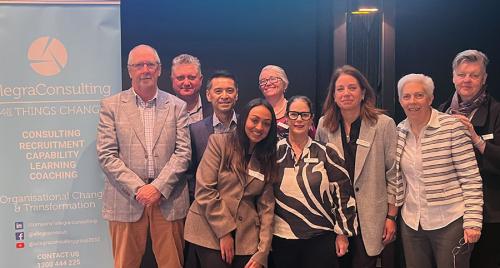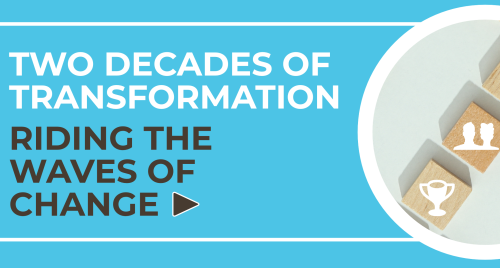Ever tried to move a couch through a narrow doorway? You push, it pushes back. You twist, it jams. You mutter something unprintable and wonder if the couch was always that wide.
That's what managing change can feel like when you meet resistance.
But here's the twist most people miss: the couch isn't trying to ruin your day. It's just reacting to being moved. So are people.
Resistance Isn't the Enemy – It's a Response
In most organisations, the word resistance gets thrown around like confetti.
- "They're being difficult."
- "They're blocking progress."
- "They just don't get it."
But what if we stopped calling it resistance altogether – and started seeing it as a response?
Because here's the truth: resistance is just human energy expressing discomfort. It's information. It's feedback. It's someone saying, "I'm unsure," or "I feel left out," or "I'm scared this change will make me less relevant."
People don't resist change – they resist loss. Loss of control. Loss of competence. Loss of belonging, and they can become anxious about the future and the unknown – it's a primitive brain response!
When we treat that response as data, not defiance, the whole dynamic shifts.
The Fog of Change – Why We Get Stuck
We're all navigating in a VUCA world – volatile, uncertain, complex, and ambiguous. It's like driving through fog with the high beams on: the more you try to force clarity, the less you can see.
In that fog, humans do what we've always done to survive: we cling to the familiar. We hold onto what feels safe.
I once worked with a team rolling out a new system meant to 'make life easier.' (Famous last words.) For months, they fought it – refused to use it, criticised it in every meeting. But when we finally listened – really listened – it turned out they were terrified. The new system automated tasks that had once been their expertise. Their resistance wasn't stubbornness; it was fear of invisibility and loss of identity.
When we addressed that fear, involved them in redesigning the workflow, and gave them ownership of the new process, their pushback turned into pride. They even became advocates for training others.
Resistance doesn't disappear when you fight it – it softens when you understand it.
Resistance Is Communication
If you listen closely enough, resistance is just a form of engagement in disguise. People only push back when they care.
Every rumour, every eye roll, every "this will never work" is a form of communication. It's someone saying, "Talk to me. Help me understand."
Leaders often rush to silence resistance instead of decoding it. But resistance, when surfaced early, can save a project. It reveals where trust is thin, where communication hasn't been effective, and where leadership needs to step in.
So, don't mute it – mine it.
Turning Pushback into Participation
When people feel involved, they move from resistance to responsibility.
Here are some of the most effective ways I've seen that happen – drawn from years of dust, debris, and lightbulb moments:
- Empathy: Start with 'I get it.' Validate the emotion before you sell the logic.
- Communication: Be transparent about what's changing, why, and what's not. Silence breeds stories, and stories fill gaps with fear.
- Involvement: Invite people into the design. You don't have to hand over the steering wheel, but at least let them help with the map.
- Support: Don't assume people will 'figure it out.' Training, coaching, and availability matter.
I once watched a senior leader start every town hall with the same sentence: "I know some of you don't like this change and that's okay..." That one line dropped the collective shoulders in the room visibly, and permission to feel uncertain changed the tone from combat to curiosity.
If you want people to buy in, don't hand them the finished meal – invite them into the kitchen.
Leaders as Thermostats, Not Thermometers
When it comes to resistance, leadership behaviour is the ultimate thermostat.
If leaders are anxious, dismissive, or inconsistent, the organisation mirrors it. If leaders stay calm, authentic, and steady, people adjust.
Active and visible sponsorship isn't a 'nice to have' – it's the single most significant predictor of change success. Sponsors can't be ghosts who sign a budget then vanish. They need to communicate directly, unblock roadblocks, and model the new behaviours themselves.
Leaders often ask, "How much should I communicate?"
Answer: "More than you think. And then again."
Because in the absence of a leadership voice, resistance grows to fill the silence.
From Resistance to Resilience
After two decades in this field, one thing's clear: most organisations aren't resistant – they're exhausted.
Change fatigue is real. People aren't digging in their heels because they hate progress – they're just running out of emotional bandwidth. The pace of transformation today means many employees have barely absorbed one shift before the next one rolls in.
In that context, resistance can be a cry for help. It's the organisational version of saying, "I can't keep sprinting."
As practitioners, we need to meet that with compassion, not frustration. Building resilience doesn't mean 'toughening people up' – it means creating breathing room, clear priorities, and space to recover.
Otherwise, resistance isn't a sign of defiance – it's a symptom of burnout.
Changing the Language Changes the Outcome
Language matters. Words shape how we think and act.
So what happens if we stop labelling people as 'resistors' and instead ask, "What are they responding to?"
It immediately shifts us from blame to curiosity. From "How do we manage them?" to "How do we understand them?"
Resistance, after all, is just energy. And energy can be redirected.
When leaders and change professionals treat every reaction as valuable input – when they listen, involve, and support – that same energy fuels momentum.
The Dance of Change
Change isn't a war to win. It's a dance to learn.
Sometimes you lead. Sometimes you follow. Sometimes you both trip over your own feet and laugh it off. But if you stay on the floor long enough, something beautiful starts to form – a rhythm, a connection, a shared movement toward the future.
The next time you encounter resistance, pause before pushing harder. Ask yourself:
- "What's really behind this reaction?"
- "What is this person protecting?"
- "What haven't they heard, understood, or been part of?"
Because once you understand that you stop fighting the rhythm – and start moving with it.
Final Beat
Resistance isn't a wall. It's a mirror. It reflects back everything we need to know about how people feel about the change, not just what they think about it.
And when we stop trying to bulldoze that mirror and start learning from it, change stops being something we do to people and becomes something we do with them.
That's when resistance turns into readiness – and change becomes less about forcing motion and more about finding rhythm.
So go on – when change pushes back, don't fight the music.










